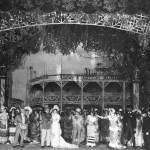 To learn the functional basics about any subject and to accumulate a working vocabulary of that field, you should know something about its history. Even artistic revolutionaries like Picasso studied the Old Masters. You wouldn’t drive forward into moving traffic without first taking at least a glance backward, would you? Over the next few weeks, I’ll offer a dozen original stage musicals and a dozen original film musicals (with some optional detours) that any student of musical theater should be familiar with.
To learn the functional basics about any subject and to accumulate a working vocabulary of that field, you should know something about its history. Even artistic revolutionaries like Picasso studied the Old Masters. You wouldn’t drive forward into moving traffic without first taking at least a glance backward, would you? Over the next few weeks, I’ll offer a dozen original stage musicals and a dozen original film musicals (with some optional detours) that any student of musical theater should be familiar with.
Let’s begin with perhaps the most influential American musical: Show Boat, written by Oscar Hammerstein II (book and lyrics) and Jerome Kern (music), based on Edna Ferber’s best-selling 1926 novel. Hammerstein and Kern had become tired of the fluffy entertainment around them: the cotton-candy operettas and high-kicking revues that filled most American stages. Each man had a substantial history in those forms, but they sought something new.
When Kern read Ferber’s novel, he saw its potential as a powerful — and musical — stage piece. Luckily Ferber agreed, and Kern brought the idea to the most successful producer of that time: Florenz Ziegfeld, best known for his fluffy Follies revues. For some reason, Ziegfeld took a chance on the show, later writing, “This is the best musical comedy I have ever been fortunate to get a hold of. I am thrilled to produce it. This show is the opportunity of my life.” He wasn’t wrong to support such an incongruous idea.
The story centers on life aboard the Cotton Blossom, a Mississippi River show boat, particularly the romance of Magnolia Hawks and Gaylord Ravenal from 1887 to 1927. The subplot involves Magnolia’s friend Julie La Verne. In addition to creating a new form of musical entertainment, the show put racial issues centerstage. In fact, it was the first racially integrated musical on Broadway — black and white performers sang alongside each other. As Ferber’s novel did, the musical also prominently featured an interracial marriage and a character of mixed race passing for white.
The show opened at the Ziegfeld Theatre on Dec. 27, 1927, with Norma Terris (Magnolia), Howard Marsh (Gaylord), Helen Morgan (Julie), and Jules Beldsoe (Joe). It was staged by Hammerstein and ran for 572 performances. After closing in May 1929, the production toured extensively, featuring Irene Dunne as Magnolia. She appeared in the 1936 film adaptation with Allan Jones (Ravenal), Helen Morgan (Julie), and Paul Robeson (Joe). Directed by James Whale, it’s a faithful screen adaptation, in part because it featured four members of the original Broadway cast and a screenplay by Hammerstein. A more popular (but slightly altered) 1951 version featured Kathryn Grayson and Howard Keel in the lead roles, with Ava Gardner and William Warfield in the supporting roles.
The musical’s notable songs include “Ol’ Man River,” “Make Believe,” and “Can’t Help Lovin’ Dat Man.” There isn’t a recording of the full 1927 original cast, but a 1932 studio recording did include Helen Morgan (Julie) and Paul Robeson (Joe) — issued in conjunction with the 1932 stage revival featuring those two actors, directed by Hammerstein. Among the numerous other recordings available, the best is the 1988 studio cast, which was the first to record the entire score, original orchestrations, and uncensored lyrics. It features Frederica von Stade (Magnolia), Jerry Hadley (Gaylord), Teresa Stratas (Juilie), and Bruce Hubbard (Joe).
Among the many stage versions, the most successful has been the 1994 Broadway revival, directed by Harold Prince. That production ran for 947 performances, before touring around the world. Prince’s production trimmed the book, reworked the score, and highlighted its racial elements.
For more about the making of the show, read Show Boat: The Story of a Classic American Musical (1977) by Miles Kreuger.
NEXT, take a detour to study another show of that era that tackled racism: Porgy and Bess, by DuBose Heyward (book and lyrics) and George Gershwin (music), which opened in 1935 on Broadway (yes — a Broadway theater, not an opera house). The best recording is from the 1976 Houston Grand Opera production.
THEN, explore the popular musical entertainment that preceded Show Boat by listening to the 1992 Welsh National Opera recording of the operetta The Mikado, the masterpiece of W.S. Gilbert (book and lyrics) and Arthur Sullivan (music) that premiered on Broadway in 1885.
